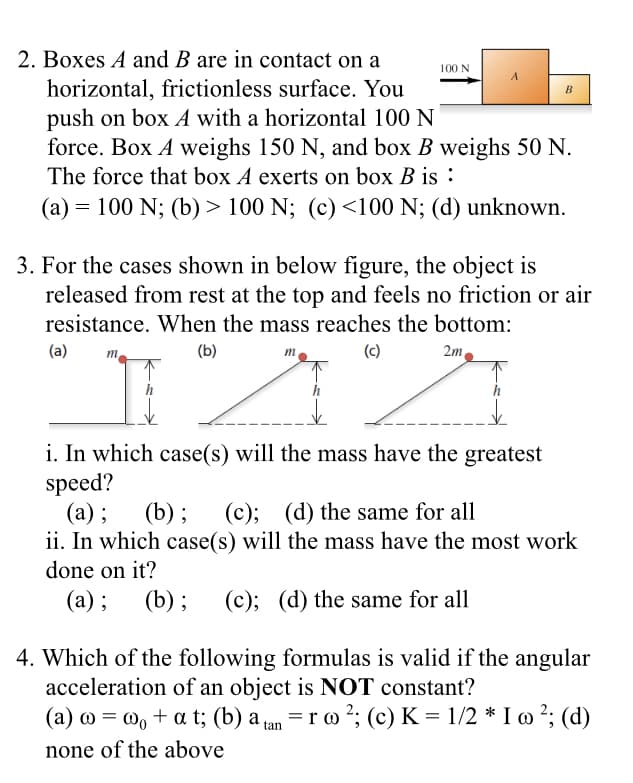2. Boxes A and B are in contact on a 100 N horizontal, frictionless surface. You push on box A with a horizontal 100 N force. Box A weighs 150 N, and box B weighs 50 N. The force that box A exerts on box B is : (a) = 100 N; (b) > 100 N; (c)<100 N; (d) unknown. B
2. Boxes A and B are in contact on a 100 N horizontal, frictionless surface. You push on box A with a horizontal 100 N force. Box A weighs 150 N, and box B weighs 50 N. The force that box A exerts on box B is : (a) = 100 N; (b) > 100 N; (c)<100 N; (d) unknown. B
Physics for Scientists and Engineers, Technology Update (No access codes included)
9th Edition
ISBN:9781305116399
Author:Raymond A. Serway, John W. Jewett
Publisher:Raymond A. Serway, John W. Jewett
Chapter14: Fluid Mechanics
Section: Chapter Questions
Problem 14.30P: The United States possesses the ten largest warships in the world, aircraft carriers of the Nimitz...
Related questions
Question
need some quick help

Transcribed Image Text:2. Boxes A and B are in contact on a
horizontal, frictionless surface. You
push on box A with a horizontal 100 N
force. Box A weighs 150 N, and box B weighs 50 N.
The force that box A exerts on box B is :
100 N
A
B
(a) = 100 N; (b) > 100 N; (c) <100 N; (d) unknown.
3. For the cases shown in below figure, the object is
released from rest at the top and feels no friction or air
resistance. When the mass reaches the bottom:
(a)
(b)
(c)
2m
m
m
i. In which case(s) will the mass have the greatest
speed?
(а) ;
ii. In which case(s) will the mass have the most work
done on it?
(b); (c); (d) the same for all
(a) ;
(b); (c); (d) the same for all
4. Which of the following formulas is valid if the angular
acceleration of an object is NOT constant?
(a) 0 = w, + a t; (b) a an = r o 2; (c) K = 1/2 * I » ²; (d)
%3D
none of the above
Expert Solution
This question has been solved!
Explore an expertly crafted, step-by-step solution for a thorough understanding of key concepts.
This is a popular solution!
Trending now
This is a popular solution!
Step by step
Solved in 2 steps

Knowledge Booster
Learn more about
Need a deep-dive on the concept behind this application? Look no further. Learn more about this topic, physics and related others by exploring similar questions and additional content below.Recommended textbooks for you

Physics for Scientists and Engineers, Technology …
Physics
ISBN:
9781305116399
Author:
Raymond A. Serway, John W. Jewett
Publisher:
Cengage Learning

College Physics
Physics
ISBN:
9781305952300
Author:
Raymond A. Serway, Chris Vuille
Publisher:
Cengage Learning

College Physics
Physics
ISBN:
9781285737027
Author:
Raymond A. Serway, Chris Vuille
Publisher:
Cengage Learning

Physics for Scientists and Engineers, Technology …
Physics
ISBN:
9781305116399
Author:
Raymond A. Serway, John W. Jewett
Publisher:
Cengage Learning

College Physics
Physics
ISBN:
9781305952300
Author:
Raymond A. Serway, Chris Vuille
Publisher:
Cengage Learning

College Physics
Physics
ISBN:
9781285737027
Author:
Raymond A. Serway, Chris Vuille
Publisher:
Cengage Learning

Physics for Scientists and Engineers: Foundations…
Physics
ISBN:
9781133939146
Author:
Katz, Debora M.
Publisher:
Cengage Learning

Principles of Physics: A Calculus-Based Text
Physics
ISBN:
9781133104261
Author:
Raymond A. Serway, John W. Jewett
Publisher:
Cengage Learning

College Physics
Physics
ISBN:
9781938168000
Author:
Paul Peter Urone, Roger Hinrichs
Publisher:
OpenStax College